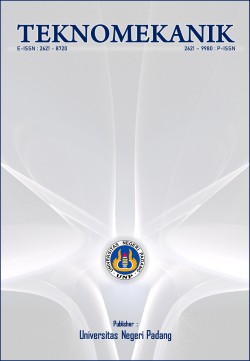Analysis of ICONNET fiber optic network improvement in cluster rayon panam at strategic business unit central sumatra PT PLN ICON PLUS
DOI:
https://doi.org/10.24036/jptk.v6i2.33723Keywords:
Bandwidth, Received power, Optical fiber, SFP, Internet connectionAbstract
Optical fiber is a telecommunications transmission medium that has a large bandwidth and bit rate so that it can meet the needs of today's data services with great reliability and efficiency. Optical fiber applications continue to be broad and have included seabed networks, terrestrial networks, metropolitan and regional scope networks, and small-scale networks. Optical fiber communication systems have 2 factors that affect the quality of network performance, namely internal aspects and external aspects. These internal and external aspects can degrade the performance quality of the optical fiber used and can cause attenuation and other transmission losses. As an effort to prevent sudden and significant deterioration in the quality of a network, it is necessary to try regular maintenance activities such as scheduled fiber optic cable network service quality measurements. These maintenance activities can help ensure network capacity increase decisions. One of the quality of service parameters that is often measured is transmission attenuation and received signal energy (received power). This research examines increasing the bandwidth capacity of PT PLN ICON PLUS in the Central Sumatra region during a network anomaly, namely a slow internet connection in the Rayon Panam Cluster. The sample taken from one of the customers shows the results of measuring the internet speed of 4-5 Mbps only, while the service taken is 10 Mbps. The results of checking on the up-link side to OLT Rayon Panam found that the data output was close to its capacity, which was 940,919,000 bits/sec or 0.9 Gb/sec. Increasing bandwidth capacity is done by moving the OLT port on the up-link side from the gigabit ethernet port to the tengigabit ethernet port, then replacing the SR type SFP with SFP ER and adding fiber optic attenuators so that the speed test results on the customer side have returned to their original appearance., 10 Mbps.
Downloads
References
Büke, T., & Köne, A. Ç. (2011). Estimation of The Health Benefits of Controlling Air Pollution from the Yataĝan Coal-Fired Power Plant. Environmental Science and Policy, 14(8), 1113–1120. https://doi.org/10.1016/j.envsci.2011.05.014
Casas-Ledon, Y., Arteaga-Perez, L. E., Dewulf, J., Morales, M. C., Rosa, E., Peralta-Suáreza, L. M., & Van Langenhove, H. (2014). Health External Costs Associated to the Integration of Solid Oxide Fuel Cell in a Sugar-Ethanol Factory. Applied Energy, 113, 1283–1292. https://doi.org/10.1016/j.apenergy.2013.08.090
Jorli, M., Van Passel, S., Sadeghi, H., Nasseri, A., & Agheli, L. (2017). Estimating Human Health Impacts and Costs Due to Iranian Fossil Fuel Power Plant Emissions through the Impact Pathway Approach. Energies, 10(12), 1–29. https://doi.org/10.3390/en10122136
Kusumawati, W., Sugiyono, A., & Bongaerts, J. C. (2010). Using the QUERI Model-AirPacts Program to Assess the External Costs of Three Power Plants in Indonesia with Three Different Energy Sources. The IMRE Journal, 4(1), 1–19. http://wordpress.hrz.tu-freiberg.de/wordpress-mu/journal/
Liun, E. (2012). Perhitungan Biaya Eksternal Pembangkit Listrik Dengan Model Simpacts. 307–321.
Mayasari, F. (2013). Analisis Perhitungan Eksternalitas Pada PLTU Muara Karang Dengan Penggunaan Flue Gas Desulphurization. Jurnal Ristek, 2(1), 38–42. www.jurnal-ristek.org
Ministry of Energy and Mineral Resources of the Republic of Indonesia. (2022). Capaian Kinerja KESDM 2021 Capaian kinerja sektor ESDM tahun 2021.
Owen, A. (2004). Environmental Externalities, Market Distortions and the Economics of Renewable Energy Technologies. The Energy Journal, 25(3), 127–156. https://doi.org/10.2307/41323045
Rokhmawati, A., Sugiyono, A., Efni, Y., & Wasnury, R. (2023). Quantifying social costs of coal-fired power plant generation. Geography and Sustainability, 4(1), 39–48. https://doi.org/10.1016/j.geosus.2022.12.004
Sugiyono, A. (n.d.). Biaya Eksternal dari Pembangkit Listrik Batubara.
Szpunar, C. B., & Gillette, J. L. (1992). Environmental Externalities: Applying the Concept to Asian Coal-Based Power Generation.
Zyśk, J., Wyrwa, A., Pluta, M., Olkuski, T., Suwała, W., & Raczyński, M. (2021). The Health Impact and External Cost of Electricity Production. Energies, 14(24), 1–19. https://doi.org/10.3390/en14248263
Downloads
Published
Issue
Section
License
Copyright (c) 2023 Hilmi Zaky Aulia, Iwa Garniwa

This work is licensed under a Creative Commons Attribution 4.0 International License.





